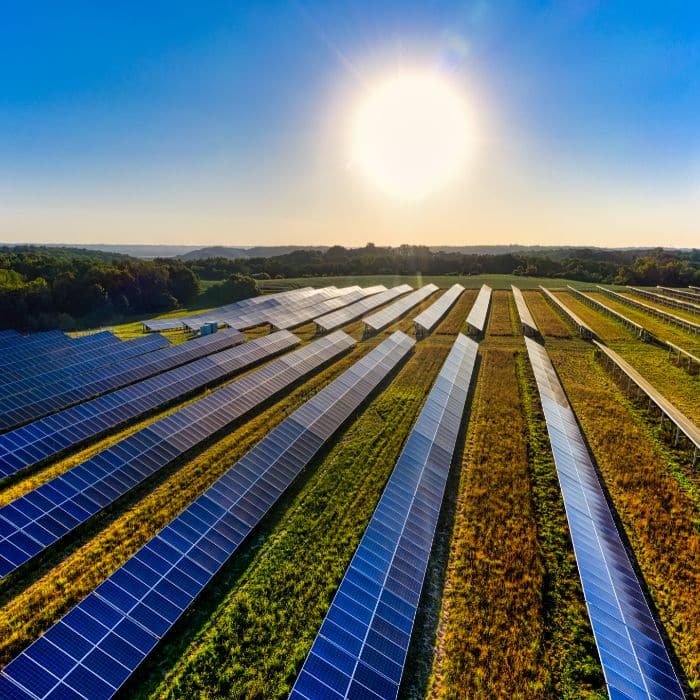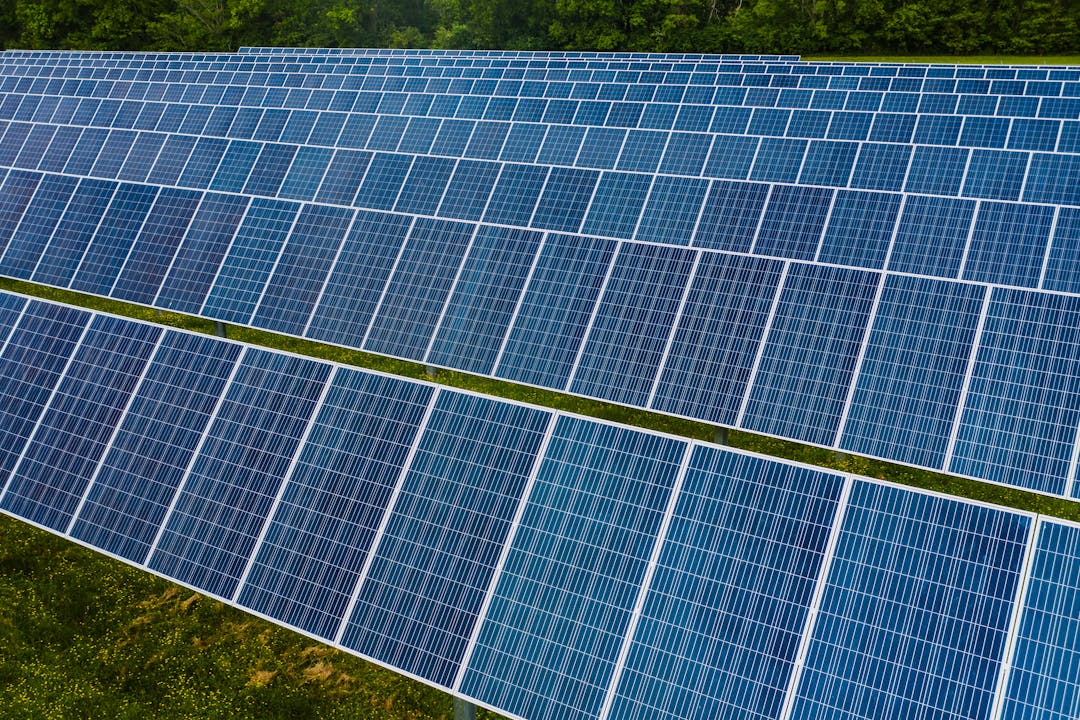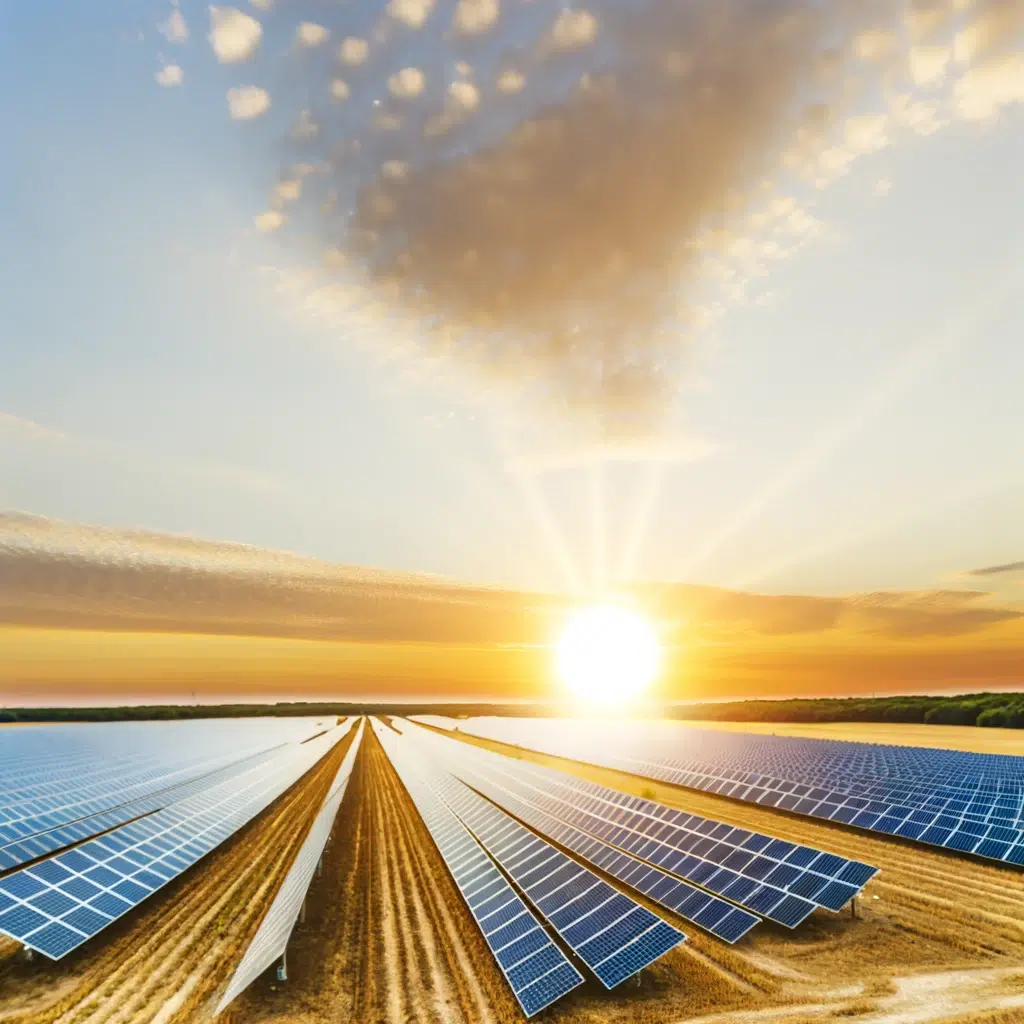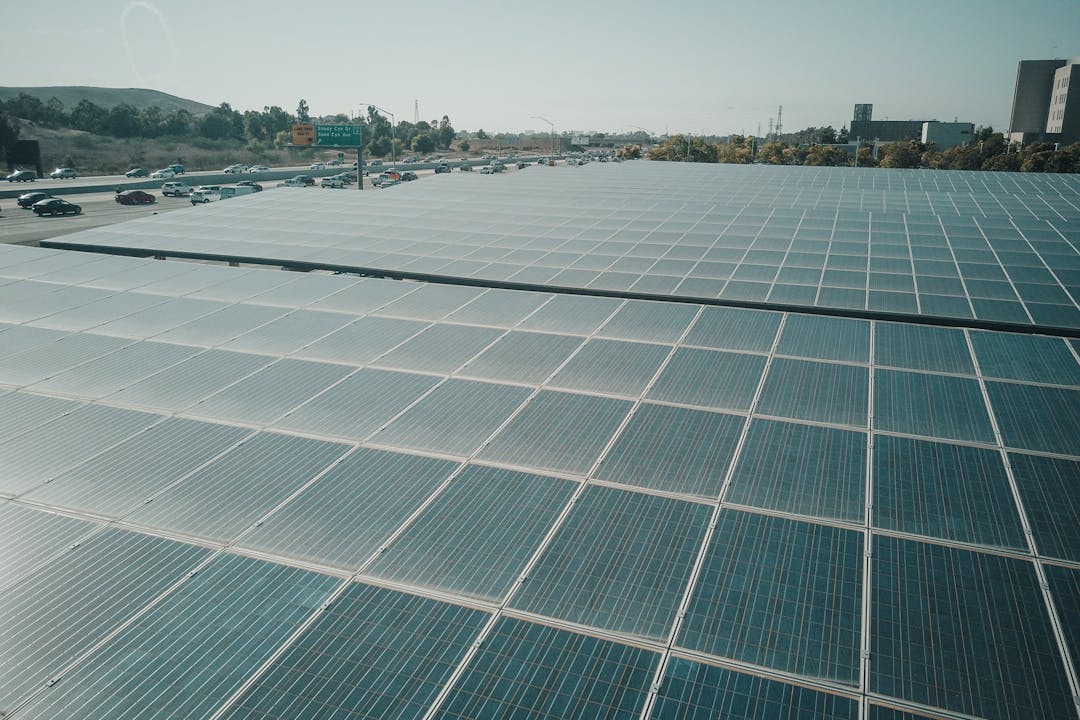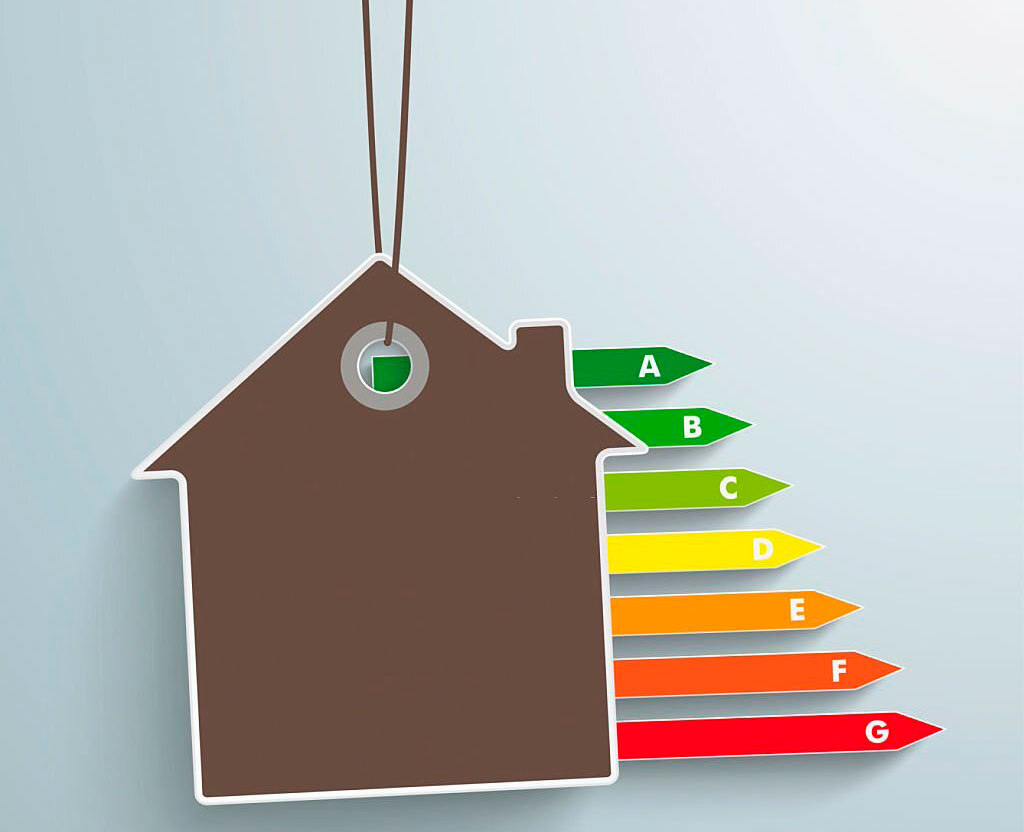Would you like to produce your own electricity from the sun and contribute to the fight against the climate change? If so, a solar farm can be an interesting option for you.
From Living Kits we'll explain what are solar farms, how they work, and what advantages and disadvantages they have, what return you can get, what legislation you must comply, what environmental impact generated, what examples are there in Spain and what future awaits them.
In this post, we delve into:
What is a solar farm?
A solar farm it is an installation of solar panels cells which are connected together and to the electrical network to generate and sell electricity from the solar radiation. Unlike systems of consumption, which are installed on roofs or facades of the houses or buildings to cover part or all of the electricity demand of the users, the solar farms are located in land or plots dedicated exclusively to the production of solar energy.
Types of solar farms
There are different types of solar farms, according to the type of connection, the type of property, type of technology, etc, below, we explain the most common:
Solar farms connected to the network
Are you inject the energy produced to the grid and receive remuneration for it. Within this type, we can distinguish two types: the sale to market and selling at a fixed price. In the sales market, the producer sells the energy to the price that is fixed in the wholesale market of electricity, which varies according to supply and demand. In the sale at a fixed price, the producer sells energy at a price set by the government, which tends to be higher than that of the market, but that is periodically reviewed.
Solar farms isolated from the network
Are those that are not connected to the electrical network and to store the energy they produce on batteries or consume directly. This type of solar farms are typically installed in areas where there is no access to the network or where the supply is poor or expensive. Solar farms isolates may be autonomous or hybrid. The self-employed and only use the solar energywhile the hybrids combine the solar energy with other sources of energy, such as diesel generators, wind turbines, hydraulic, etc
Solar farms shared
Are those that are formed by multiple owners or investors who share the installation and the benefits. This type of solar farms are typically created by cooperatives, associations, communities, neighbors, etc orchards solar sharing can be connected to the network or isolated from the network, according to the case. Solar farms shared allow participants to access the solar energy without having to install panels on their own homes or buildings, which reduces costs and entry barriers.
Gardens solar-tracking
Are the ones that use mechanical systems to guide the solar panels towards the sun throughout the day, which increases the production of energy. The solar farms of follow-up may be of a-axis or two-axis, according to the degree of freedom that have the panels to rotate. The solar farms of follow-up have a higher efficiency than solar farms fixed, but also a higher cost and increased maintenance.
How does a solar farm?
The operation of a solar farm it is based on the photovoltaic effect, which consists in the transformation of light energy from the sun into electrical energy. The solar panels photovoltaic are in charge of capturing the solar radiation and convert it into direct electric current. This current is then sent to an inverter, which converts it into alternating current, which is used in most of the electrical appliances. The alternating current can be injected to the grid, stored in batteries or consume directly, depending on the type of connection you have the solar farm. In addition, the solar farm account with other components, such as the counter, the regulator, the transformer, the wiring, the support structure, etc
Components of a solar farm
The main components of a solar farm are the following:
Photovoltaic solar panels
Are the devices that capture solar radiation and convert it into electricity. They are formed by cells photovoltaics, which are the basic units of the photovoltaic effect. Cells photovoltaics are made with semiconductor materials such as silicon, which receive the light generated by an electric potential difference. The solar panels they are classified according to the type of cell used, which may be monocristalina, polycrystalline or thin-film. The panels monocrystalline have a higher efficiency and durability, but also a higher cost. Polycrystalline panels have lower efficiency and durability, but also a lower cost. The panels thin film have a very low efficiency and durability, but are more flexible and lightweight.
Inverter
It is the device that converts the dc power generated by the solar panels in alternating current, which is used in most of the electrical appliances and injected to the network. The inverter must be adapted to the power and the voltage of the installation, as well as the standards of quality and safety of the network. The investor also has the functions of control, protection and monitoring of the solar farm.
Counter
It is the device that measures the amount of energy that produces the solar farm and it is consumed or injected into the network. The counter must be approved and certified by the electric company, which installs and reads. The timer allows the grower to know the energy balance and economic development of their solar farm, as well as to comply with their tax obligations and administrative.
Regulator
It is the device that regulates the flow of energy between the solar panels, the inverter, the batteries, and consumers. The regulator prevents overloads, short-circuits, deep discharges or reverse polarity could damage the components of the solar farm. The avr is essential in solar farms isolated, where the batteries play a key role.
Batteries
They are devices that store the energy produced by the solar farm when it is not consumed or injected to the network. The batteries provide power when there is no sun or when there are power outages. The batteries must be suitable for the use of pv, as they must endure cycles of charge and discharge frequent and prolonged. The batteries most commonly used are lead-acid, lithium and nickel-cadmium.
Transformer
It is the device that raises or lowers the voltage of the alternating current produced by the inverter, according to the voltage level of the network or of the consumers. The transformer allows you to adapt the solar farm to the conditions of the network and optimize the transport of the energy. The transformer can be integrated in the inverter or be an external element.
Wiring
Is the set of cables and connectors that carry the energy between the different components of the solar farm. The wiring should be of good quality and resistant to environmental conditions, as well as to comply with the standards of safety and isolation. The wiring must be sized properly to prevent a loss of power and overheating.
Support structure
Is the set of elements that sustain and secure the solar panels the ground or the surface where it is installed. The support structure must be robust and stable, as well as allow the orientation and inclination optimum of the panels. The support structure may be fixed or mobile, depending on the type of solar farm.
Advantages of solar farms
The solar farms have many advantages, both for producers and for society in general. Among these advantages are:
- Take advantage of a renewable source of energy, inexhaustible and free, as is the sun, which reduces the dependence on fossil fuels and their price fluctuations.
- Contribute to the fight against the climate change, to prevent the emission of greenhouse gases and other pollutants generated by conventional energy sources.
- Promote rural development, to create jobs, wealth and opportunities in the areas where they are installed, as well as to improve the access to the electric power to isolated communities or disadvantaged.
- Generate savings and profitability, to allow producers to reduce your electric bill, get income from the sale of the power and benefit from the grants and tax incentives that exist for this type of facilities.
- Favor the diversification and security of energy supply, to increase the participation of renewable energy in the energy mix and to reduce the losses in transport and distribution of energy.
- Promote the democratization and citizen participation in the energy sector, to facilitate the access to the electric power generation by models of shared ownership, credit union, or community.
Disadvantages of solar farms
Solar farms also have some disadvantages or drawbacks that you must take into account. Among these disadvantages are:
- Require high upfront investment, which may pose a barrier to entry for some producers, or inverters, even if it can be recovered in the medium or long term.
- Depend on the availability and variability of the solar radiation, which can be affected by factors such as seasonality, weather, latitude, topography, etc
- Occupy a considerable surface of the ground, which can compete with other uses or activities, such as agriculture, livestock, biodiversity conservation, etc
- Need regular maintenance and proper, which involves an additional cost and a constant supervision, to ensure the smooth operation and security of the installation.
- Generate an environmental and visual impacts, which can alter the landscape, the flora and fauna of the area where they are located, as well as cause discomfort to neighbors or users of the infrastructure nearby.
Profitability of solar farms
The profitability of the solar farms depends on several factors, including the cost of the installation, the price of energy, the solar radiation of the area, the type of connection, the grants and incentives available, etc
These factors can vary significantly from one day to another and from one location to another. Therefore, it can be difficult to predict with accuracy the amount of energy that will result in a solar system in a given day.
We can use artificial intelligence to improve the accuracy of the forecasts of solar production. Analyze large amounts of data such as solar radiation, historical, temperature, cloudiness, and time of day. This shows patterns and trends that can be used to more accurately predict the production of solar energy. Predict the production of solar energy it is important for many reasons.
In the first place, can help owners of solar systems to take decisions on energy management more informed. For example, if it is expected that a photovoltaic system to generate a significant amount of energy in a given day, the owner may decide to sell this energy back to the grid.
In the second place, to predict the production of solar energy you can help the network operators to balance supply and demand of energy. This will help to prevent blackouts and power outages. This tool is very powerful since it can be used to improve the efficiency and sustainability systems solar energy. Predict the output of solar energy it is just one of the many promising applications of artificial intelligence in the field of energy photovoltaic.
To calculate the profitability of a solar farmtend to use two indicators: the time of return of the investment and the internal rate of return.
- The return time of the investment is the time it takes to recover the money invested in the solar farmfrom the income and savings that are obtained by the production of energy. It is calculated by dividing the cost of the installation between the yearly net profit. For example, if the cost of the installation is 100,000 euros, and the yearly net profit is 10,000 euros, the return time of the investment is 10 years.
- The internal rate of return is the percentage of profit that you get for the money invested in the solar farmtaking into account the present value of the future cash flows. Is calculated by a mathematical formula that equates the present value of the income and expenses to zero. For example, if the cost of the installation is 100,000 euros, and the annual revenues and expenses are 15,000 and 5,000 euros respectively, the internal rate of return is 10%.
The profitability of solar farms has improved in recent years, thanks to the reduction in the cost of solar panels, the increase in the price of electricity and the simplification of administrative procedures. According to a study of the Spanish Union Photovoltaic (UNEF), the average profitability of solar farms connected to the grid in Spain is 7.5%, with a payback time of the investment of between 10 and 12 years.
A good news for the sector is that the Royal Decree-law 17/2019 established that will continue over the next 12 years, the rate of return set by the Government for the so-called first period, regulatory, is to say that producers of renewable energy will continue to gain what they were charging per kilowatt hour produced until the year 2030.
Legislation on solar farms
The legislation on solar farms is the set of rules and regulations that govern the installation, the operation, the connection, the remuneration and taxation of solar farms in Spain. The legislation on solar farms has undergone several changes in recent years, which has led to legal uncertainty and has affected the profitability and the development of this type of facilities.
The current legislation on solar farms is based on the Royal Decree 244/2019, of 5 April, regulating the administrative, technical and economical of the consumption of electrical energy, which entered into force on 6 April 2019. This royal decree establishes the following methods of self-consumption:
Self-consumption without a surplus
It is the one that occurs when the energy generated by the solar farm it is consumed entirely by the user, without injecting anything into the network. This mode does not require counter or contract with the electric company, but do not receive any remuneration for the energy produced.
Self-consumption, with surpluses
It is the one that occurs when the energy generated by the solar farm exceeds the demand of the user, and inject the surplus to the network. This mode requires an accountant, and a contract with the electric company, and receives remuneration for the injection energy. Within this mode, you can distinguish two submodalidades:
Self-consumption, with surpluses being compensation
It is the one that applies when the user has a contracted power less than or equal to 100 kW, and chooses to compensate the surplus energy injected with the deficit of energy consumed in the network, in the same billing period. The compensation is performed to the price of the energy from the wholesale market, with a maximum limit of 100% of the amount of the electric bill, excluding taxes, tolls and fees. This submodalidad is tax exempt to the sun and the tax on electricity.
Self-consumption, with surpluses are not covered by compensation
It is the one that applies when the user has a contracted power exceeding 100 kW or do not opt for the compensation. In this case, the user sells the power injected to the network at the market price, but must pay the tax to the sun and the tax on electricity, as well as tolls and fees.
In addition to the royal decree mentioned, the legislation on solar farms also consists of other standards, such as:
- the Law 24/2013, of 26 December, of the Power Sector, the Royal Decree 413/2014, on June 6, which regulates the activity of production of electrical energy from renewable energy sources, cogeneration and waste
- the Royal Decree 900/2015, 9 October, which regulates the administrative, technical, and economic modes of supply of electrical energy with consumption and production with self-consumption
- the Royal Decree 15/2018, 5 October, on urgent measures for the energy transition and the protection of consumers, the Royal Decree 23/2020, June 23, by adopting measures in the field of energy and in other areas for the economic revival, etc
The legislation on solar farms can vary depending on the autonomous community, which has competence in matters of energy and environment. For this reason, it is advisable to consult the specific regulations of each region before starting a project solar farm.
Environmental impact of solar farms
The environmental impact of solar farms is the set of effects that the installation and operation of solar farms have on the environment, both at local and global levels. The environmental impact of solar farms can be positive or negative, depending on the type and magnitude of the effects.
The positive environmental impact
- Use a renewable source of energy, inexhaustible and free, as is the sun, which reduces the dependence on fossil fuels and their price fluctuations.
- Avoid the emission of greenhouse gases and other pollutants generated by conventional energy sources, which contributes to the fight against the climate change and to the improvement of the quality of the air.
- Promote rural development, to create jobs, wealth and opportunities in the areas where they are installed, as well as to improve the access to the electric power to isolated communities or disadvantaged.
- Favor the diversification and security of energy supply, to increase the participation of renewable energy in the energy mix and to reduce the losses in transport and distribution of energy.
- Promote the democratization and citizen participation in the energy sector, to facilitate the access to the electric power generation by models of shared ownership, credit union, or community.
The negative environmental impact
- Occupy a considerable surface of the ground, which can compete with other uses or activities, such as agriculture, livestock, biodiversity conservation, etc
- Generate a visual impact, which can alter the landscape, the flora and fauna of the area where they are located, as well as cause discomfort to neighbors or users of the infrastructure nearby.
- Produce waste, both during the manufacture, transport, installation and maintenance of the components of the solar farmas at the end of its useful life, which must be managed properly to avoid contamination.
- Consume resources, both material and energy, manufacturing, transport, installation and maintenance of components of the solar farm, which must be optimized to reduce their ecological footprint.
For all of the above, in most cases, it is necessary to conduct an Environmental Impact Study (EIA) to install a solar farm. This is due to the fact that the installation and operation of a solar farm you can have several impacts on the environment and the surrounding community, which must be assessed and managed appropriately.
A study of environmental impact assessment (EIA) is a systematic and thorough process that evaluates the potential effects of a project, plan, or activity may have on the environment and human health. This type of study is crucial for making informed decisions and responsible for the development of projects, as it allows to identify, prevent and mitigate the negative impacts on the natural and social environment.
For this reason, it is a fundamental tool for the responsible environmental management and sustainable projects, as it allows you to anticipate and manage negative impacts on the environment and the community, thereby contributing to informed decision-making and sustainable development.
The EIA is to provide objective and scientific information on the potential environmental impacts of a project, which helps the decision makers to consider these impacts during the planning and execution of the project. In addition, it allows the public participation in the decision-making process, encouraging transparency and the inclusion of different perspectives.
The main parts of an environmental impact study
- Project description: Details are given of the nature of the project, its location, size, scope, and objectives.
- Environment description: It analyzes the characteristics of physical, biological, social and cultural of the area of influence of the project, including the flora, fauna, soils, water resources, landscape, human population and economic activities.
- Identification of impacts: It assesses the potential direct and indirect environmental impacts that the project may have on the natural and social environment. These impacts may include changes in the quality of air, water and soil, loss of habitat, noise pollution, alterations in the dynamics of human populations, among others.
- Impact assessment: We analyze the magnitude, duration, scope, and significance of the identified impacts, as well as its probability of occurrence. Using specific methods and tools to assess the impacts on the basis of scientific and regulatory frameworks.
- Proposals for mitigation measures and compensation: Proposed actions and strategies to prevent, minimize, or compensate for the negative environmental impacts of the project. These measures may include the implementation of cleaner technologies, the conservation of natural habitats, the restoration of degraded areas, among others.
- Plan follow-up and monitoring: Establishing a detailed plan for the continuous monitoring of the environmental impacts during all stages of the project, as well as for the compliance assessment of the mitigation measures and compensation proposals.
To minimize the negative environmental impact of solar farms, are to be applied criteria sustainability and good environmental practices in all phases of the project, from planning to operation. These measures include:
- Perform an environmental impact study prior, assess the potential effects of the solar farm on the environment and to propose corrective measures or countervailing duties.
- Choose a suitable location, which has a good solar radiation, which does not affect the protected or high ecological value, that does not generate conflicts with other uses or activities, that respects the landscape and the cultural heritage, that has a good access to the power grid, etc
- The use of materials and quality equipment, that have high efficiency, long durability, low toxicity, ease of recyclability, low carbon footprint, etc
- To optimize the design and the dimensioning of the installation, which is adapted to the ground conditions, that make the most of the solar radiation, which reduces the energy losses, which minimize the use of resources, which facilitate the maintenance, etc
- Follow the standards of quality and safety, to ensure the proper functioning and protection of the installation, of workers, of the users and the environment, both during construction and during the operation.
- Regular maintenance and appropriate, to prevent, and correct possible malfunctions, failures or impairments of the installation, to ensure the performance and security of the same, that avoid the generation of waste or emissions, which respects the current regulations, etc
- Properly managing the waste, whether generated during the manufacture, transport, installation and maintenance of the components of the solar farm, such as those which occur at the end of its useful life, must be collected, separated, treated, recycled or disposed of properly, according to its nature and its danger, in compliance with the applicable legislation.
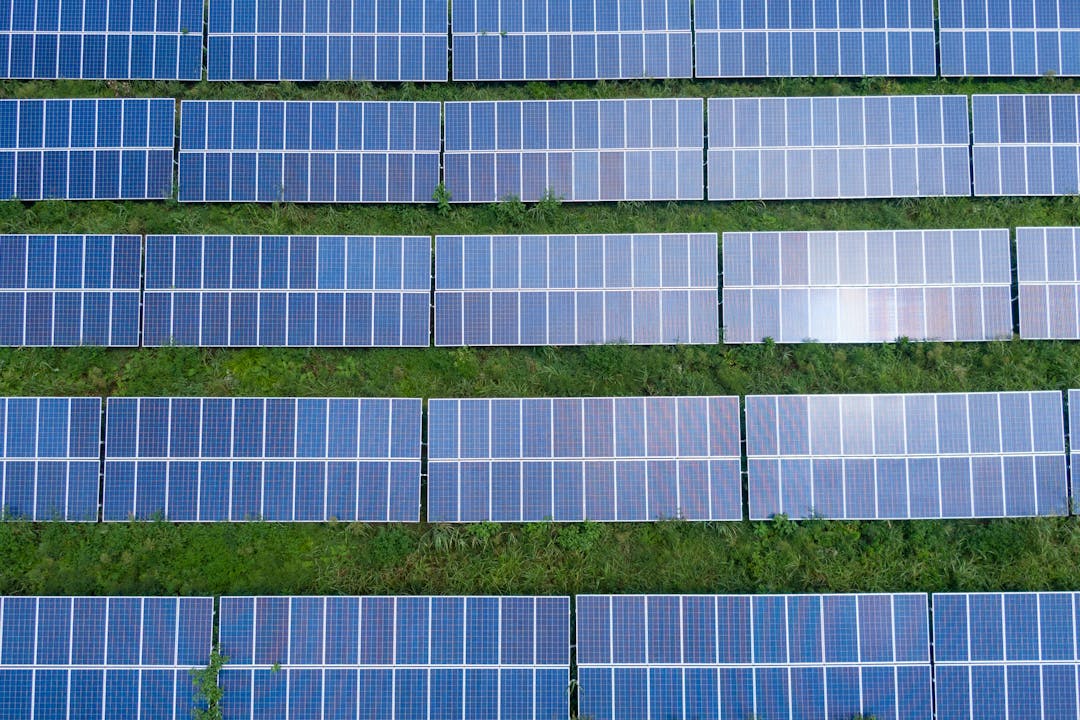
Solar farms in Spain
Spain is one of the countries with the greatest potential for the development of solar farms, due to their high solar radiation, the extensive area of land available, your experience and technological capacity in the photovoltaic sector, its commitment to the energy transition and the decarbonisation of the economy, etc.
According to the report “The state of the renewable energy in Spain 2020” of the Association of Enterprises of Renewable Energy (APPA), the solar energy photovoltaic contributed 6.1% of the electricity demand nationwide in 2020, with an installed power of 13.314 MW, of which 4.752 MW correspond to new projects connected to that year. The solar energy photovoltaic generated 27.479 GWh of electricity, which represents an increase of 67.5% compared with the previous year. The solar energy photovoltaic prevented the emission of 9.2 million tonnes of CO2 and generated a gross value added of 4.591 million euros, as well as 38.210 direct and indirect jobs.
The greater part of the power photovoltaic installed in Spain corresponds to solar farms connected to the network, which are located mainly in the autonomous communities of Extremadura, Andalucía, Castilla-La Mancha, Aragón and Castilla y León.
Some examples of solar farms in Spain are:
The Solar Platform of Almeria
It is the largest center of research, development and testing of solar technologies in Europe, with an installed capacity of 40 MW and an area of 103 hectares. The Solar Platform of Almería is home to different facilities and projects solar energy, both photovoltaic as thermal, ranging from the generation of electricity to the desalination of water, through the production of hydrogen or the air conditioning of buildings.
The photovoltaic plant Núñez de Balboa
It is the largest plant photovoltaic of Europe, which has an installed capacity of 500 MW and a surface area of 1,000 hectares. The plant photovoltaic of Núñez de Balboa is located in the municipality of Usagre, in Badajoz, and was inaugurated in 2020. The plant photovoltaic of Núñez de Balboa, it can supply electricity to 250,000 people and avoid the emission of 215,000 tons of CO2 per year.
The photovoltaic plant Mule
It is the largest plant photovoltaic of consumption of Spain, with an installed capacity of 450 MW and an area of 1088 acres. The plant photovoltaic Mula is located in the municipality of Mula, Murcia, and was connected to the grid in 2019. The plant photovoltaic Mule is formed by 12 solar farms shared, which supply electricity to more than 200,000 homes and businesses in the region.
Future of solar farms
The future of solar farms is promising, as it is expected to continue to grow and expand around the world, driven by the need to increase the generation of renewable energy, reduce greenhouse gas emissions, improve the safety and quality of electricity supply, to promote the economic and social development, etc
According to the report “Renewable Energy Market Update 2021” of the International Energy Agency (IEA), the solar energy photovoltaic it will be the renewable energy source that more will grow in the coming years, with a forecast of add 162 GW of installed power in 2021 and 179 GW in 2022, an increase of 18% and 10% respectively compared to the previous estimates. The solar energy photovoltaic it will represent 46% of new renewable capacity will be installed in the world in 2021, and 43% in 2022.
The report “Global Market Outlook for Solar Power 2020-2024” of SolarPower Europe, the european association of the solar industry, provides that the power photovoltaic installed in Europe to reach 253 GW in 2024, representing an increase of 80% compared to 141 GW that had been at the end of 2019. Spain is the second country with the highest power photovoltaic installed in Europe in 2024, with 34 GW, behind only Germany, with 72 GW.
Frequently asked questions on solar farms
What is solar energy?
The solar energy it is the energy that is obtained from the use of the solar radiation that reaches the Earth. The solar energy can be used to generate electricity, heat or fuels, using different technologies, such as the photovoltaic, the thermal or thermoelectric.
How do solar panels?
The solar panels are the devices that capture solar radiation and convert it into electricity or heat. The solar panels they are classified according to the type of technology they use, which can be photovoltaic or thermal. The solar panels photovoltaics convert sunlight into direct electrical current through the photovoltaic effect. The solar panels thermal transform sunlight into heat, by the effect of solar thermal power.
What kinds of solar panels are there?
The types of solar panels following are the most common:
- Solar panels photovoltaic: they Are classified according to the type of cell used, which may be monocristalina, polycrystalline or thin-film. The panels monocrystalline have a higher efficiency and durability, but also a higher cost. Polycrystalline panels have lower efficiency and durability, but also a lower cost. The panels thin film have a very low efficiency and durability, but are more flexible and lightweight.
- Solar panels thermal: they Are classified according to the type of fluid used, which may be water or air. The solar panels thermal water heat water that circulates through tubes, which is stored in a tank or is used directly for domestic or industrial. The solar panels thermal air, heats the air which circulates in tubes, which is used to heat spaces or for drying agricultural products or industrial.
What is the self-consumption of energy?
The self-consumption energy it is the mode of consumption of electrical energy, which is to generate and consume their own energy, without relying on the power grid or reducing to the minimum the dependence of the same. The self-consumption energy you can make it with different sources of renewable energy, such as solar, wind, hydro, biomass, etc. self-consumption energy it has advantages such as savings, efficiency, sustainability, autonomy, participation, etc
What is the difference between a solar farm and a solar park?
Although the terms solar farm and solar arrays are often used interchangeably, there are some differences between them. A solar farm tends to have an installed capacity of less than one solar park, which can reach several megawatts (MW) or even gigawatts (GW). In addition, a solar farm usually consists of several owners or investors who share the installation and the benefits, while a solar park is usually belong to a single company or entity.
By having a vision mode conceptual a solar farm it has a size of less than 15 hectares and its production is limited to an amount between 5 and 10 MW. That is to say, the main difference between a solar farm and a solar plant lies in its size, ownership and objective:
Solar farm
- Size: Small generation facilities photovoltaic.
- Title: They belong to different owners, who share the expenses, the maintenance and the benefits.
- Objective: Cater to small businesses, small centres of population or agricultural producers.
Solar plant
- Size: Large tracts of land with facilities photovoltaics.
- Title: They tend to be owned by a company or legal entity.
- Objective: Supplying large companies, large urban areas or even to pour the energy to the electricity grid.
Other differences
- Investment: Solar farms require a smaller investment than solar power plants.
- Technology: Solar power plants usually use the most advanced technology solar farms.
- Environmental impact: The solar arrays have a lower environmental impact that the solar plants.
Examples of solar farms and solar power plants:
Solar farms:
- Solar farm colegio San Gabriel (Madrid)
- Solar farm of the agricultural cooperative Progress (Seville)
- Solar farm city Council Malaga
Solar power plants:
- Solar plant photovoltaic Benidorm (Alicante)
- Solar plant photovoltaic Puertollano (Ciudad Real)
- Solar plant photovoltaic of Nuñez de Balboa (Badajoz)
For what purpose you can use the power of a solar farm?
The energy of a solar farm can be used for several purposes, depending on the type of connection you have. If the solar farm is connected to the mains power, the power it produces is injected directly into the network and sold to the company a distributor or marketer, getting a remuneration for each kilowatt hour (kWh) generated. If the solar farm is isolated from the network, the energy produced is stored in batteries or directly consumed by users who are connected to the garden, as the case may be in rural or remote areas.
What size can have a solar farm?
The size of a solar farm depends on various factors, such as the available surface, the desired power, the orientation and inclination of the panels, the solar radiation of the area, the type of connection, etc, In general, it is estimated that you will need a surface of between 10 and 15 square feet for every kilowatt peak (kWp) of installed power. So, for example, a solar farm 100 kWp would need a surface area of between 1,000 and 1,500 square feet.
Who can install a solar farm?
Any natural person or legal entity may install a solar farm, provided that you comply with the legal requirements, technical and administrative demand for this type of facilities. Among these requirements are: to have a suitable piece of land, apply for permits and licenses, hire an installation company authorised to conduct the study of economic viability, registered in the register of producers of electric power, take out civil liability insurance, etc
How can I install a solar farm on my house?
To install a solar farm in your house, you must follow the following steps:
- To study the technical and economic viability of the project, taking into account the solar radiation, the surface area available, the desired power output, the type of connection, the cost of the installation, the price of energy, the grants and incentives available, etc
- Apply for the necessary permits and licenses, both to the local administration as the electric company, to carry out the installation and connection of the solar farm.
- Hire an installation company authorised, to be responsible to supply, install and launch the components of the solar farm, as well as process documentation and registration of the same.
- Enjoy solar energy that produces the solar farm, consumiéndola, by selling it or compensándola, depending on the type of connection you have chosen.
How much does it cost to install a solar farm?
The cost of installing a solar farm depends on various factors, such as size, location, type of connection, the quality of materials, the design of the installation, etc., however, we can estimate that the average cost per kWp installed around 1,000 euros, which represents an investment of about € 100,000 for a solar farm 100 kWp. This cost has to be added to the maintenance costs, which are usually between 1% and 2% of the installation cost per year.
What aids are there to install a solar farm?
There are various types of aid and incentives to install a solar farmboth at the state level as a regional or local, which may be economic, fiscal, administrative, or technical. Among these grants are to be found:
Grants
Are direct subsidies that are granted to the fund lost to finance part or all of the cost of the installation of the solar farm. Grants can come from different government agencies, such as the Institute for the Diversification and Saving of Energy (IDAE), the autonomous communities, municipalities, etc
Loans
Are financial aid that is granted to a preferential rate or tempered to finance part or all of the cost of the installation of the solar farm. Loans can come from different financial institutions, such as banks, savings banks, credit unions, etc, often with conventions or lines of funding for specific projects renewable energy.
Tax deductions
Are aid tax that consists in reducing the taxable amount or the fee to pay in taxes related to the installation of the solar farm. The tax deductions can be applied in various taxes, as the Tax on the Income of Natural Persons (personal income TAX), corporate Tax (IS), the Value Added Tax (VAT), the Real Estate Tax (IBI), etc.
Administrative simplification
Aids bureaucratic consisting of streamline or eliminate the requirements and procedures to install and connect the solar farm. The administrative simplification can affect different aspects, such as the application of permits and licenses, registration, the contract with the electric company, etc
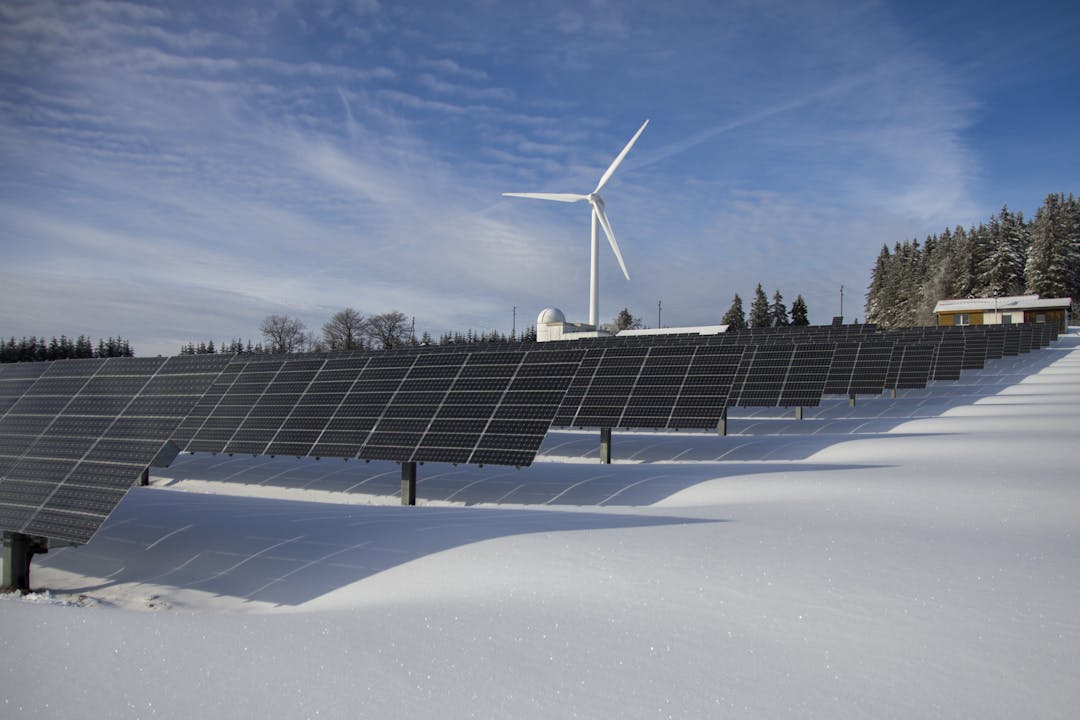
What are the challenges facing the future of solar farms?
The future of solar farms also poses some challenges and challenges that need to be faced and overcome in order to ensure its viability and sustainability. Among these challenges are:
- To reduce the cost of the solar energy photovoltaic that, although it has declined significantly in recent years, it is still higher than that of other energy sources, which can limit their competitiveness and profitability. To do this, we must continue to innovate and improve the materials, equipment, processes and techniques of the solar industry, as well as take advantage of the economies of scale and synergies with other sectors.
- To increase the efficiency and durability of the solar panels that, although they have reached very high levels, still have room for improvement, which may increase the production and the performance of the solar arrays. To do this, you should continue researching and developing new technology, such as the cells of perovskite, the cells, heterojunction cells, multi-junctions, cells, organic, etc
- Integrate solar farms in the electrical network which, due to its nature variable and intermittent, can lead to problems of stability, quality and security of electricity supply, which can affect the operation and to the balance of the electrical system. To do this, you should implement storage solutions, demand management, smart grids, flexible markets, etc
- To minimize the environmental and social impact of solar farms that, although it is lower than that of other sources of energy, it can still have negative effects on the environment and local communities, which can lead to conflict or rejection. To do this, you must apply criteria of sustainability and good environmental practices in all phases of the project, from planning to operation, as well as to promote the participation and awareness of the actors involved.
What maintenance needs to a solar farm?
The maintenance of a solar farm is the set of actions that are performed to ensure the proper functioning and security of the facility, as well as to optimize its performance and extend its useful life. The maintenance of a solar farm it can be of two types: preventive or corrective.
Preventive maintenance
Is carried out periodically, according to a plan set out, to prevent possible damage, failure or deterioration of the installation. Preventive maintenance includes actions such as cleaning, checking, adjustment, lubrication, change or replacement of the components of the solar farm.
Corrective maintenance
It is performed when it is detected or a fault occurs, a fault or a deterioration of the installation, which prevents or hinders its normal operation. Corrective maintenance includes actions such as repair, replacement, modification, or improvement of the components of the solar farm.
The maintenance of a solar farm it can be performed by the owner or by a specialized company, which is responsible for monitoring, control and solve problems that may arise in the installation. The cost of the maintenance of a solar farm is typically between 1% and 2% of the installation cost per year.
Is it cost-effective to install a solar farm?
The profitability of a solar farm depends on several factors, including the cost of the installation, the price of energy, the solar radiation of the area, the type of connection, the grants and incentives available, etc, To calculate the profitability of a solar farmtend to use two indicators: the time of return of the investment and the internal rate of return.
- The return time of the investment is the time it takes to recover the money invested in the solar farmfrom the income and savings that are obtained by the production of energy. It is calculated by dividing the cost of the installation between the yearly net profit. For example, if the cost of the installation is 100,000 euros, and the yearly net profit is 10,000 euros, the return time of the investment is 10 years.
- The internal rate of return is the percentage of profit that you get for the money invested in the solar farmtaking into account the present value of the future cash flows. Is calculated by a mathematical formula that equates the present value of the income and expenses to zero. For example, if the cost of the installation is 100,000 euros, and the annual revenues and expenses are 15,000 and 5,000 euros respectively, the internal rate of return is 10%.
The profitability of solar farms has improved in recent years, thanks to the reduction in the cost of solar panels, the increase in the price of electricity and the simplification of administrative procedures. According to a study of the Spanish Union Photovoltaic (UNEF), the average profitability of solar farms connected to the grid in Spain is 7.5%, with a payback time of the investment of between 10 and 12 years.
A good news for the sector is that the Royal Decree-law 17/2019 established that will continue over the next 12 years, the rate of return set by the Government for the so-called first period, regulatory, is to say that producers of renewable energy will continue to gain what they were charging per kilowatt hour produced until the year 2030.
What are the environmental impacts from a solar farm?
The environmental impact of a solar farm is the set of effects that the installation and operation of solar farms have on the environment, both at local and global levels. The environmental impact of solar farms can be positive or negative, depending on the type and magnitude of the effects.
The positive environmental impact
- Use a renewable source of energy, inexhaustible and free, as is the sun, which reduces the dependence on fossil fuels and their price fluctuations.
- Avoid the emission of greenhouse gases and other pollutants generated by conventional energy sources, which contributes to the fight against the climate change and to the improvement of the quality of the air.
- Promote rural development, to create jobs, wealth and opportunities in the areas where they are installed, as well as to improve the access to the electric power to isolated communities or disadvantaged.
- Favor the diversification and security of energy supply, to increase the participation of renewable energy in the energy mix and to reduce the losses in transport and distribution of energy.
- Promote the democratization and citizen participation in the energy sector, to facilitate the access to the electric power generation by models of shared ownership, credit union, or community.
The negative environmental impact
- Occupy a considerable surface of the ground, which can compete with other uses or activities, such as agriculture, livestock, biodiversity conservation, etc
- Generate a visual impact, which can alter the landscape, the flora and fauna of the area where they are located, as well as cause discomfort to neighbors or users of the infrastructure nearby.
- Produce waste, both during the manufacture, transport, installation and maintenance of the components of the solar farmas at the end of its useful life, which must be managed properly to avoid contamination.
- Consume resources, both material and energy, manufacturing, transport, installation and maintenance of components of the solar farm, which must be optimized to reduce their ecological footprint.
To minimize the negative environmental impact of solar farms, are to be applied criteria sustainability and good environmental practices in all phases of the project, from planning to operation. These measures include:
- Perform an environmental impact study prior, assess the potential effects of the solar farm on the environment and to propose corrective measures or countervailing duties.
- Choose a suitable location, which has a good solar radiation, which does not affect the protected or high ecological value, that does not generate conflicts with other uses or activities, that respects the landscape and the cultural heritage, that has a good access to the power grid, etc
- The use of materials and quality equipment, that have high efficiency, long durability, low toxicity, ease of recyclability, low carbon footprint, etc
- To optimize the design and the dimensioning of the installation, which is adapted to the ground conditions, that make the most of the solar radiation, which reduces the energy losses, which minimize the use of resources, which facilitate the maintenance, etc
- Follow the standards of quality and safety, to ensure the proper functioning and protection of the installation, of workers, of the users and the environment, both during construction and during the operation.
- Regular maintenance and appropriate, to prevent, and correct possible malfunctions, failures or impairments of the installation, to ensure the performance and security of the same, that avoid the generation of waste or emissions, which respects the current regulations, etc
- Properly managing the waste, whether generated during the manufacture, transport, installation and maintenance of the components of the solar farm, such as those which occur at the end of its useful life, must be collected, separated, treated, recycled or disposed of properly, according to its nature and its danger, in compliance with the applicable legislation.
I hope this article helped you to better understand what are solar farms, how they work, and what advantages and disadvantages they have, what return you can get, what legislation you must comply, what environmental impact generated, what examples are there in Spain and what future awaits them. If you have any questions or comments, do not hesitate to contact me. Thanks for reading.

